Archive for March, 2016
-
Safety at sea
Although the sea may be perceived as a barrier, in ancient times, when no infrastructure existed on land, it was actually the medium which connected one country to another. Travelling on the sea had its own risks and so eventually the idea of insuring a ship and its cargo developed. Traces of the first arrangements between merchants date back to the Roman Period, starting from contracts of sea loans and evolving through the centuries into more complex marine insurances.
Along their history, the Maltese Islands often formed part of important trade routes and therefore local merchants were soon involved in this sector of underwriting risks. A wealth of information related to this aspect is available in old documents which show the development of insurance that was offered against particular risks on the sea. Nonetheless, till now, the origins and progress of marine insurance in Malta have been given little attention.
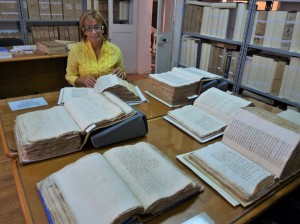 A visit to the Notarial Archives in Valletta where I met historian Dr Joan Abela introduced me to this interesting theme. Always ready to divulge enticing narratives from the valuable sources of these archives, Abela prepared for me a distinguished selection of thick manuscripts in order to help me explore the fine details available within.
A visit to the Notarial Archives in Valletta where I met historian Dr Joan Abela introduced me to this interesting theme. Always ready to divulge enticing narratives from the valuable sources of these archives, Abela prepared for me a distinguished selection of thick manuscripts in order to help me explore the fine details available within.“In antiquity, before marine insurance originated, a sea loan was the only means of transferring risks in maritime transport from the shipper to another person. This consisted of two partners, a traveling and a sedentary one, who pooled their capital in order to invest and share the risk together. With such an agreement, the travelling partner would have more money in hand to work with, whereas the sedentary one would be able to make a profit while staying on land to continue with his work and at the same time avoid the perils that existed out at sea,” explained Abela.
By the Late Middle Ages, as Italian merchants, particularly from Genoa, continued to experiment on these issues of securing vessels and their cargo, marine insurance gradually began to replace this type of agreement.
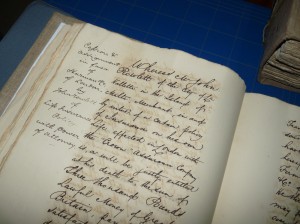 “Since marine insurance was still in its early stages of development, contracts did not adopt a uniform pattern, but varied considerably according to the exigencies of the contractors. Insurance contracts were usually categorized as Securitas by the notary, and were generally divided into two parts.”
“Since marine insurance was still in its early stages of development, contracts did not adopt a uniform pattern, but varied considerably according to the exigencies of the contractors. Insurance contracts were usually categorized as Securitas by the notary, and were generally divided into two parts.”“The first section listed the insurers’ names and the guaranteed premium which was calculated according to the routes, the prevailing conditions along these routes, the type of cargo, and also the type of ship being used. It also covered the kind of information which was regarded as essential for such a contract, that is, the name of the persons insured, specific details regarding the ship which was to undertake the venture, and other specifications regarding the merchandise and its destination. The second part of the contract usually listed the obligations of the insurers, the rights of those insured, and the method of payment.”
 Abela guided me through the Latin elegant black ink scripture which dated to centuries ago. Interestingly, at the beginning of some contracts, prior to the insertion of the usual stereotyped clauses, notaries included an invocation of God’s blessing for a safe trip.
Abela guided me through the Latin elegant black ink scripture which dated to centuries ago. Interestingly, at the beginning of some contracts, prior to the insertion of the usual stereotyped clauses, notaries included an invocation of God’s blessing for a safe trip.‘Al nome De Dio bon viaggio et salvamento Amen’ started a contract dated May 1558.
“Divinity was also cited in other parts of the contracts,” revealed Abela. “In fact, the listing of the perils was often preceded by the phrase che Dio non voglia.”
Abela noted also that although at the time, mariners had a great devotion for the Virgin Mary which is evident from ex-voto paintings, Her name and also the names of saints were not usually mentioned when appealing for such spiritual protection in between legal phrases. This contrasted with the names given to ships that were often named after the Madonna and various saints.
“Indeed these manuscripts can shed light on various subject matters. Amongst the wide data available, one can note the different vessels that were used during the different periods, the names of these ships, the ports to which they travelled, the type of cargo that was carried, and the amount of money which was being insured on it.”
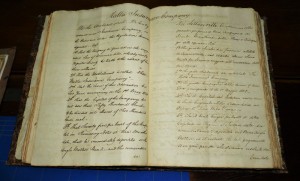 “An insurance contract which was concluded on 4 April 1536 stated that the insurance policy covered a shipment of 18 cantari of spun cotton that was going to be loaded from Birgu and shipped to Licata on the fusta of Giacomo Bonnichi. This fusta was to be captained by Paolo Xuejl or by any other captain appointed in his stead, and was secured to travel to any port which may have been deemed necessary for the purpose of the expedition.”
“An insurance contract which was concluded on 4 April 1536 stated that the insurance policy covered a shipment of 18 cantari of spun cotton that was going to be loaded from Birgu and shipped to Licata on the fusta of Giacomo Bonnichi. This fusta was to be captained by Paolo Xuejl or by any other captain appointed in his stead, and was secured to travel to any port which may have been deemed necessary for the purpose of the expedition.”Interestingly, a clause in the above contract stated that although being insured, the captain was expected to act prudently and to behave as if he was not being offered this protection, in order not to compromise the safety of the merchandise.
“Should any damage or loss occur to the insured goods, the insurers were usually expected to pay the amount insured without any objection within four months from the incident. Yet as we can see from some documents, such as the petition that was put forward by Nob. Giacomo Bonichi against Mag. Pietro Ros and Giovanni Exatopolo in relation to a contract enrolled in the acts of notary Vincenzo Bonaventura de Bonetiis in 1560, the clients were not always satisfied with the way in which claims were met.”
Abela pointed out to a most interesting contract which referred to an insurance of a consigment of apothecary products for the Order’s Infirmary. The list of products acted almost as a showcase of those ingredients which the Hospitallers used in order to produce the required medicine for their patients.
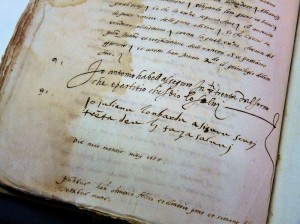 “Those who succeeded to establish themselves in this sector had to have great entrepreneurial skills since this business was still in its infancy and there were lots of risks which one had to deal with. Antonio Habell and Giuliano Lombardo were two of the earliest local entrepreneurs who besides being merchants and traders, they also offered marine insurance services, as may be noted in an insurance contract which they endorsed in respect of the safe consignment of a shipment of timber from Licata in 1558.”
“Those who succeeded to establish themselves in this sector had to have great entrepreneurial skills since this business was still in its infancy and there were lots of risks which one had to deal with. Antonio Habell and Giuliano Lombardo were two of the earliest local entrepreneurs who besides being merchants and traders, they also offered marine insurance services, as may be noted in an insurance contract which they endorsed in respect of the safe consignment of a shipment of timber from Licata in 1558.”Abela lead me to the book Trade and Port Activity in Malta 1750-1800 (2000) by John Debono where one can find detailed research related to aspects of marine insurance.
“As Debono elucidates, marine risks involved were numerous and included: inconsistency in the weather, the questionable conduct of a crew which was generally poorly and irregularly paid and usually comprised men who could not find work ashore, plundering or being taken as a slave by pirates, the unreliability of basic sea charts and portolani which only showed the depth of the water, and the perils that war brought with it.”
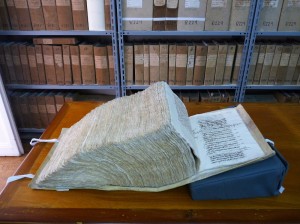 This study underlines also that initially, undewriters operated on an individual basis up to circa 1771, and those notaries which succeeded did very well financially. From an examination of insurance policies between September 1754 and August 1755 drawn up by notary Agostino Marchese, who at the time was most renowned with underwriters and insured, reveals that no less than 109 marine underwiters during that period insured a total sum of 686, 385 scudi against marine risks. However, by the 1770s individual undewriters were being replaced by insurance firms and in 1771, we see the establishment of the first insurance company in Malta.
This study underlines also that initially, undewriters operated on an individual basis up to circa 1771, and those notaries which succeeded did very well financially. From an examination of insurance policies between September 1754 and August 1755 drawn up by notary Agostino Marchese, who at the time was most renowned with underwriters and insured, reveals that no less than 109 marine underwiters during that period insured a total sum of 686, 385 scudi against marine risks. However, by the 1770s individual undewriters were being replaced by insurance firms and in 1771, we see the establishment of the first insurance company in Malta.A few years later, the Maltese Islands were in a state of turmoil as they were briefly occupied by the French and this led to a total collapse of the whole local insurance system. A new chapter in this sector initiated with the beginning of the British rule.
(This article was published in the Shipping and Logistics Supplement which was issued with the Times of Malta on 30th March 2016)
-
Take me to church
“ ‘They have hit our church!’ cried a man as he stumbled down in the tunnel which was located under the Mall Garden. We were huddling in there for shelter together with many other people as the bombs came down over Floriana,” reminisced Pawlu Piscopo who was eight at the time.
 “At this horrible news, my father grabbed me and my brother by the hand and took us out of the tunnel and over to the granaries where a very sad spectacle awaited us. St Publius’ Church had suffered a direct hit. Its dome was gone and the area was surrounded in rubble. Thirteen people who were taking cover in the church’s crypt were killed and eleven more were injured. That was the blackest moment in the history of the parish church of Floriana: April 28, 1942 at 7:50am.”
“At this horrible news, my father grabbed me and my brother by the hand and took us out of the tunnel and over to the granaries where a very sad spectacle awaited us. St Publius’ Church had suffered a direct hit. Its dome was gone and the area was surrounded in rubble. Thirteen people who were taking cover in the church’s crypt were killed and eleven more were injured. That was the blackest moment in the history of the parish church of Floriana: April 28, 1942 at 7:50am.”After their house had been bombed, Pawlu’s family were allowed to take some respite in a large residence which today houses the Floriana Local Council. Yet for four years, they lived mostly underground in this tunnel which probably saved their lives. They took with them only a few belongings and the most cherished items, including a statue of St Publius which dated back to 1928 and used to adorn the model altar that his father had constructed at home.
“Most families in Malta had a model of an altar or a miniature church at home at the time. Unfortunately, many of these had to be abandoned during the war and a good number of them were destroyed when the houses were bombed.”
The craft of church model-making had been introduced to our islands by the Knights of St John back in the 16th century, and therefore its knowledge was a distinct tradition. However the adversity of war ravaged even this precious memory until eventually this craft was almost completely forgotten.
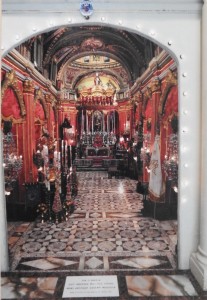 “After the war, people tried to get on with their lives as best as they could. Shops started to open again but those that used to sell miniature items with which to decorate our religious models, dwindled down to almost none. Nevertheless, the passion for model-making was much engrained in our family and when I bought a miniature structure made of four columns and a dome from a man who was leaving Malta to go to live in Australia, my father Carmelo was inspired to use it as the foundation for a model of St Publius’ church,” explained Pawlu.
“After the war, people tried to get on with their lives as best as they could. Shops started to open again but those that used to sell miniature items with which to decorate our religious models, dwindled down to almost none. Nevertheless, the passion for model-making was much engrained in our family and when I bought a miniature structure made of four columns and a dome from a man who was leaving Malta to go to live in Australia, my father Carmelo was inspired to use it as the foundation for a model of St Publius’ church,” explained Pawlu.Carmelo was a very skilled carpenter. He would go from time to time to have a look at the church and then go back to his model and construct an exact copy of the section that he had seen.
“He used the material which was handy at the time, mostly cardboard, wood and gypsum. I helped him out too in order to build the whole church which included ten altars. Eventually, this model reached a huge size of three by four metres and we could walk in it and look above at the beautiful dome,” Pawlu said proudly.
Once his father grew old, Pawlu continued with the work on this church which they had started back in the early 1960s. As he embellished this model, the wish to set up a group for model-makers in order to share this passion with them, burnt within him.
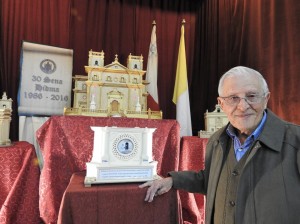 “On February 26, 1986 which happenned to be the tenth anniversary of my father’s demise, I discussed this idea with two of my friends, Raphael Micallef and Tony Terribile, who were very interested in this sector. We all agreed to do something in order to revive this craft and we sent out adverts in the newspapers to announce the set up of this group which we called Għaqda Dilettanti Mudelli ta’ Knejjes (Church Modelling Society). We were very happy when we received a great response from enthusiastic individuals all over Malta. Soon, a commitee was formed and on March 1986, we organized the first exhibition during the first two weeks of Lent wherein the members displayed the works that they had.”
“On February 26, 1986 which happenned to be the tenth anniversary of my father’s demise, I discussed this idea with two of my friends, Raphael Micallef and Tony Terribile, who were very interested in this sector. We all agreed to do something in order to revive this craft and we sent out adverts in the newspapers to announce the set up of this group which we called Għaqda Dilettanti Mudelli ta’ Knejjes (Church Modelling Society). We were very happy when we received a great response from enthusiastic individuals all over Malta. Soon, a commitee was formed and on March 1986, we organized the first exhibition during the first two weeks of Lent wherein the members displayed the works that they had.”It was certainly a great satisfaction to see this society thrive and grow along the years, always adding up new members of various ages. Today, around 400 members form part of this group which operates from its premises at 37, East Street, Valletta.
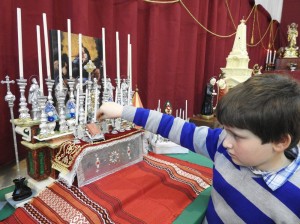 “This year we are delighted to celebrate the 30th anniversary from the establishment of this society,” Pawlu said. “The annual exhibition has been taking place each year. Besides offering the opportunity to showcase our members’ works, this event has served to help our members and the public which visits it, to meditate during the Lent period and to prepare for the Easter celebrations.”
“This year we are delighted to celebrate the 30th anniversary from the establishment of this society,” Pawlu said. “The annual exhibition has been taking place each year. Besides offering the opportunity to showcase our members’ works, this event has served to help our members and the public which visits it, to meditate during the Lent period and to prepare for the Easter celebrations.”A bi-monthly magazine, Il-Knisja Tiegħi (My Church), which was also initiated by Pawlu, is marking its 30th anniversary too. Members have been writing features in it related to different aspects of religious folklore, thereby kindling even further interest in model-making.
Once again this year, the society has organized this exhibition which saw the participation of several of its members. Exhibits varied and included small to large statues of the passion of Christ and Easter, statues of Blessed Mary and several saints, models of altars, church facades and whole churches made of different materials.
 “I hope that I’ll have enough strength to exhibit my large model of St Publius’ church,” revealed Pawlu at one point. “It takes me four weeks to set it up on a large platform and to connect the miniature chandeliers and light fittings to electricity. I am getting old now and such work is very tiring.”
“I hope that I’ll have enough strength to exhibit my large model of St Publius’ church,” revealed Pawlu at one point. “It takes me four weeks to set it up on a large platform and to connect the miniature chandeliers and light fittings to electricity. I am getting old now and such work is very tiring.”Pawlu has been exhibiting this model in a building besides the Floriana Cathecism Museum for many years now, during the feast of St Publius which takes place two weeks after Easter.
“Many people come to visit my model and they are fascinated with it. Tourists take photos besides it and they ask me how I managed to construct it section by section and yet making it look as a whole. I tell them that there are lifetimes of passion invested within it and that it is imbued with a blend of religious meaning and local traditional skills and creativity.”
At 82 years, Pawlu is serene and thankful to see the society which he has founded together with his friends strengthen itself and adding members to it.
“I just wish that it will continue to flourish for very long,” smiled Pawlu as he looked contentedly around him in order to appreciate the beautiful displayed works of the society’s members.
(This article was published in the Easter Supplement which was issued with The Times of Malta dated 21st March 2016)
-
Guests to history
One would probably spare only a few moments of consideration at the receipt of a wedding invitation. However, for Baron Igino de Piro d’Amico Inguanez, these endearing solicitations were cherished so much that he kept a collection of them, neatly separated according to their date and wrapped up together by a string.
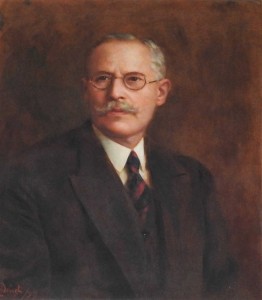 “Were it not for my grandfather’s interest to keep these wedding invitations, we would have lost this fascinating information which can be unravelled within each one of them,” remarked Marquis Nicholas de Piro as we walked towards an elegant table in one of the rooms at Casa Rocca Piccola where he had layed out a number of these invitations.
“Were it not for my grandfather’s interest to keep these wedding invitations, we would have lost this fascinating information which can be unravelled within each one of them,” remarked Marquis Nicholas de Piro as we walked towards an elegant table in one of the rooms at Casa Rocca Piccola where he had layed out a number of these invitations.I glanced out at the wide selection of wedding invitations tastefully set on the polished wooden surface, noticing the different sizes, shapes, writing, designs and paper. The earliest ones dated back to 1815, 1829 and 1832. They were quite plain and small, slightly bigger than a credit card, and written in Italian.
“Here are two of the prettiest ones” said the Marquis as he pulled them out of the rest.
These two invitations had been issued at the end of the 19th century. They were larger than the earlier ones and were quite different from each other. The one dated June 1896 was elegantly designed with an intricate cross at its corner and consisted of an invitation to the wedding between the noble Maria de Piro and Dr. Alfredo Stilon. The other one dated October 1899 was more colourful and rather than an invitation, it was more an announcement of the wedding which was to take place between the noble Maria Teresa de Piro and the Marquis Paolo Apap Bologna. Once again, both were written in Italian.
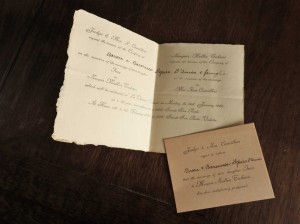 “Now look at this note which accompanies this wedding invitation,” said the Marquis as he handed it to me.
“Now look at this note which accompanies this wedding invitation,” said the Marquis as he handed it to me.The presentation of this wedding invitation was simpler than the previous two and the writing was in English. Here, Judge and Mrs L Camilleri were requesting the company of Baron and Baroness I de Piro d’Amico Inguanez and family to the wedding of their noble daughter Inez to Marquis Mallia Tabone on 26th January 1920. Yet this celebration was not destined to take place as a smaller card which was sent some days later informed those invited that this wedding had been indefinitely postponed.
 “From these invitations, one can also observe the traditional customs of the various eras. For example, this wedding invitation dated 1935 shows clearly that people who chose to get married during the period of Lent had to abide to some limitations.”
“From these invitations, one can also observe the traditional customs of the various eras. For example, this wedding invitation dated 1935 shows clearly that people who chose to get married during the period of Lent had to abide to some limitations.”Indeed, a formal note which was inserted together with the wedding invitation that was sent by Chev & Mrs E Moore and Mrs H Xuereb to announce the marriage of their daughter Alice Moore to Godfrey Xuereb, provided this information with direct instructions:
‘It is much regretted that in view of the restrictions imposed by Canon Law for weddings held in Lent, only a few guests may attend the religious ceremony at the Archbishop’s Palace.
You are therefore invited to meet the bride and bridegroom immediately after the ceremony at the residence at 4:00pm.’
 As we followed the different invitations that were sent along the years to Baron Igino and his family, we could also trace some of his friends and acquaintances, their residences, the chapels and churches where the marriages took place, and the selected locations for the wedding receptions. Although many of the churches still exist today, some of the street names had changed from Italian to English or were altered completely. A number of the residences mentioned have become quite renowned today whilst a few others were turned into commercial properties. Sadly, some of the lovely villas which provided exquisite entertainment in the bygone days were demolished to make place for large modern complexes.
As we followed the different invitations that were sent along the years to Baron Igino and his family, we could also trace some of his friends and acquaintances, their residences, the chapels and churches where the marriages took place, and the selected locations for the wedding receptions. Although many of the churches still exist today, some of the street names had changed from Italian to English or were altered completely. A number of the residences mentioned have become quite renowned today whilst a few others were turned into commercial properties. Sadly, some of the lovely villas which provided exquisite entertainment in the bygone days were demolished to make place for large modern complexes.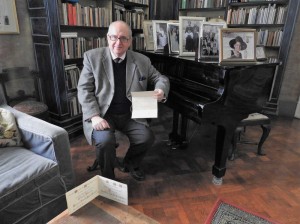 Amongst these, there was the wedding between Hilda Scicluna and Paymaster Lieutenant W Eric Brockman that took place on 4th March 1928. Their marriage was celebrated at the Archbishop’s Palace in Valletta which seems to have been quite a popular venue for such occasions. On the other hand, the reception was held at the bride’s parents residence that was located at 86 Strada Merkanti Valletta; a house which originally belonged to Sir Oliver Starkey, Bali of Aquila and Latin Secretary to Grand Master La Valette. Being an English Knight, he had assisted the Grand Master during the Great Siege of 1565 and was later given the privilege to be buried in the crypt of the Co-Cathedral of St John in Valletta, close to La Valette’s own burial place.
Amongst these, there was the wedding between Hilda Scicluna and Paymaster Lieutenant W Eric Brockman that took place on 4th March 1928. Their marriage was celebrated at the Archbishop’s Palace in Valletta which seems to have been quite a popular venue for such occasions. On the other hand, the reception was held at the bride’s parents residence that was located at 86 Strada Merkanti Valletta; a house which originally belonged to Sir Oliver Starkey, Bali of Aquila and Latin Secretary to Grand Master La Valette. Being an English Knight, he had assisted the Grand Master during the Great Siege of 1565 and was later given the privilege to be buried in the crypt of the Co-Cathedral of St John in Valletta, close to La Valette’s own burial place.The Cathedral in Mdina seems to have been another prominent place for marriages. On 24th January 1937, Adelina Maempel was married to Edwin England Sant Fournier. A reception followed at Villa Luginsland in 26 Boschetto Road, Rabat; a lovely villa which was built by Baron Max von Tucker, the German consul who was serving in Malta in the early 20th century. Unfortunately in recent years years, this remarkable place was in an abandoned state and had a haunting atmosphere.
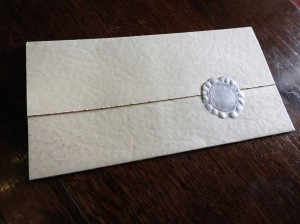 The only wedding invitation which came from Gozo looked quite distinguished and it boasted a silver wax seal. The marriage of Carmela and Paul Vella took place on 4th August 1937 and their reception was organized at the Duke of Ediburgh Hotel in Victoria, Gozo. Alas, in recent years, this splendid hotel that was beautifully constructed in Victorian architecture was demolished in order to make way for a commercial centre and a number of residential units.
The only wedding invitation which came from Gozo looked quite distinguished and it boasted a silver wax seal. The marriage of Carmela and Paul Vella took place on 4th August 1937 and their reception was organized at the Duke of Ediburgh Hotel in Victoria, Gozo. Alas, in recent years, this splendid hotel that was beautifully constructed in Victorian architecture was demolished in order to make way for a commercial centre and a number of residential units.“As you have already noted, some of these wedding invitations pertained to our relatives. Incidentally, this one which announces the marriage between my aunt Mona de Piro to Major John E J Nelson on 28th December 1940 is a favourite of mine, particularly because she was quite a character and she kept her high spirits even when she was aged more than ninety. Well, she’s there, looking at us!” the Marquis exclaimed as he pointed to a delightful portrait on the opposite wall.
My eyes met with those of a young, graceful girl, defiantly posing with an off-the-shoulder silver dress which melted in the greyish background behind her.
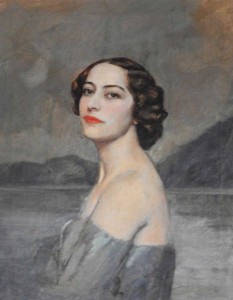 “That portrait created much talk when her relatives saw it since it was regarded too sensual at the time. It was commissioned by her Italian boyfriend, Marquis Onofrio Bartolini Salinbeni, and the painting was done by Arthur Acton who lived in a palace in Florence. Onofrio was madly in love with Mona but unfortunately, their relationship ended and when she returned to Malta, a relative of hers went to Italy to claim this painting since it was not deemed fit for him to keep it,” smiled the Marquis as he went to add some logs to the fire burning in the stylish hearth besides us.
“That portrait created much talk when her relatives saw it since it was regarded too sensual at the time. It was commissioned by her Italian boyfriend, Marquis Onofrio Bartolini Salinbeni, and the painting was done by Arthur Acton who lived in a palace in Florence. Onofrio was madly in love with Mona but unfortunately, their relationship ended and when she returned to Malta, a relative of hers went to Italy to claim this painting since it was not deemed fit for him to keep it,” smiled the Marquis as he went to add some logs to the fire burning in the stylish hearth besides us.A warm gush of air embraced the room as the logs protested and cracked and poured a glowing light over the wedding invitations lying in front of us. For a short spell, I thought that I could hear the tinkling of the glasses filled with red velvety wine and golden sizzling champagne as the guests toasted to the newly married couples.
(This article was published in the Weddings Supplement issued with The Sunday Times of Malta dated 13th March 2016)
Travelogue
Archives
Recent Posts
- A MATTER OF FATE
- MALTA’S PREHISTORIC TREASURES
- THE MAGIC IS IN THE DETAIL
- THE SELLING GAME
- NEVER FORGOTTEN
- Ġrajjiet mhux mitmuma – 35 sena mit-Traġedja tal-Patrol Boat C23
- AN UNEXPECTED VISIT
- THE SISTERS OF THE CRIB
Comments
- Pauline Harkins on Novella – Li kieku stajt!
- admin on IL-KARNIVAL TRAĠIKU TAL-1823
- Albert on IL-KARNIVAL TRAĠIKU TAL-1823
- Martin Ratcliffe on Love in the time of war
- admin on 24 SENA ILU: IT-TRAĠEDJA TAL-PATROL BOAT C23